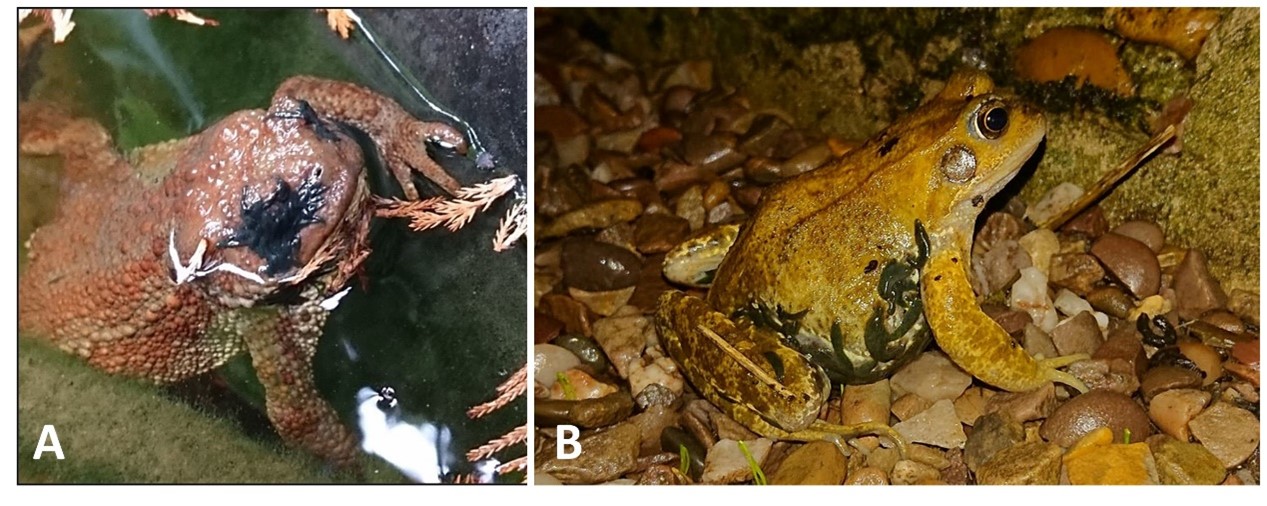Agent
Leeches (Hirudinea) are a small yet ecologically important group of highly specialised segmented worms. There are 17 different species of freshwater leech known in the UK, four of which have been reported to sometimes feed on live amphibians: the medicinal leech (Hirudo medicinalis), Glossiphonia paludosa, Hemiclepsis marginata, and Placobdella costata. The horse leech (Haemopis sanguisuga), Erpobdella spp., and Dina lineata may also feed on dead or moribund adult amphibians as part of their natural diet.
Following recent observations of severe leech infestation affecting common toads (Bufo bufo) and common frogs (Rana temporaria) in southern England, Batracobdella algira, a leech species not previously reported in Great Britain (GB), has been identified.
Species affected
Some native leeches in GB may feed on vertebrates, including amphibians.
Batracobdella algira, the leech species recently discovered in GB, is known to feed on several species of amphibian in its known geographic range (see Distribution).
Signs
Leeches may attach to any part of the body of affected amphibians. Batracobdella algira leeches have typically been observed to attach on or around the eyes of common toads (Fig. 1A) as well as the throat, armpits, and occasionally the underside of the body. This distribution on common toads may be due to leeches avoiding areas with glands that produce toxic skin secretions.
In common frogs, B. algira leeches have been seen distributed over the entire body, on occasion also covering the eyes, although most often on the underside and armpits (Fig. 1B).
It is important to be aware that it is not possible to distinguish between parasitism by B. algira and native leech species based on their distribution/feeding behaviour on common frogs and common toads, or the leech appearance as seen with the naked eye.
Although interactions between leeches and their vertebrate hosts are poorly understood, it is known that leeches sometimes use amphibians as an opportunistic food source, generally without leading to severe health impacts. However, impairment of vision caused by leeches covering the eyes of amphibians will likely affect their ability to forage or evade predators.
To date, there is no evidence of native leech species affecting amphibians in GB on a population level, however, the significance of the recently detected B. algira to amphibian health is yet to be established. In its native habitat, B. algira is not known to have negative health or population impacts on amphibians.
Figure 1. A common toad (Bufo bufo) reported from Devon, England, in 2020, with leeches covering both eyes and attaching to the throat (A). A common frog (Rana temporaria) reported from the Isle of Wight, England, in 2020, with leeches attaching to the underside of its body. Using molecular methods, in both cases, the leeches were identified as Batracobdella algira. Photo credits: Chryssa M.L. Brown and Charis Hayles.
Transmission
Leeches may be introduced to a new water body via natural routes (e.g. attached to live animals such as amphibians or water birds), or through human activity (e.g. movement/trade of water plants, live animals, or other objects from one pond to another).
Distribution
Leech species in GB are reported with varying geographical ranges. Some species that may feed on amphibians are widespread across the country.
Batracobdella algira is usually found in freshwater habitats in the Mediterranean rim (e.g., Algeria, Tunisia, the Pyrenean Peninsula, Balearic Islands, Corsica, Sardinia, and Sicily) as well as in Bulgaria and the Ukraine. In GB, this species has to date only been confirmed from southern England (Isle of Wight, Devon, and Somerset), however, since surveillance for these cryptic species is challenging, it may be present in other areas and as yet undiscovered. Whether B. algira has been historically overlooked in England or is a recently introduced species, remains unknown. Sightings and investigations of Batracobdella species remain scarce, and the overall understanding of their true global and local distribution and diversity is limited.
Further surveillance of amphibian leech predation is required to gain a better understanding of the true geographical range and frequency of occurrence of B. algira.
Risk to human health
Whilst leeches may attach to a range of vertebrate hosts, reports of leeches attaching to people in GB are rare, and there are no known risks posed by B. algira to human health.
Risk to domestic animal health
Since pet amphibians are typically housed indoors, the risk of leech predation is negligible. Keeping pet amphibians in outdoor enclosures is not recommended to protect the health of both captive and free-living animals alike. It is advised to maintain good levels of biosecurity avoiding contact between captive and wild amphibians.
Identification
Differentiation between B. algira and other known native freshwater leeches feeding on amphibians (e.g. P. costata) requires expert morphological and often molecular laboratory investigation as these leeches generally look like other leeches that feed on amphibians in GB. The feeding behaviour of B. algira is indistinguishable from that of known native leeches predating amphibians.
If you wish to report the observation of leech predation, or finding a dead or unwell amphibian, please visit www.gardenwildlifehealth.org. Alternatively, if you have further queries or have no internet access, please call the Garden Wildlife Health vets on 0207 449 6685.
Control and prevention
Leeches feeding on amphibians or other hosts is a natural phenomenon and usually does not require intervention; attempts of removal of attached leeches may cause harm to amphibians or leeches alike. In severe cases that may raise concerns around amphibian welfare, please seek veterinary advice. The movement of affected animals, or other live animals, plants or objects from a pond, should be avoided to help prevent the unintentional spread of leeches, and/or any pathogens they may carry, to new areas.
Further information
More advice on amphibians in your garden can be found on the Garden Wildlife Health website www.gardenwildlifehealth.org or on www.froglife.org.
Scientific publications
Seilern-Macpherson, K., Lawson, B., Macadam C. R., West, P., Reed, N., Gibson, L., Świątek, P., Gajda, Ł., Cunningham, A. A., Heaver, J. & Julian, J. M (2024) Predation of anurans in southern England by Batracobdella algira, a leech previously unknown in the UK. Herpetological Journal 34, 221–227. doi.org/10.33256/34.4.221227
Kvist, S., Utevsky, S., Marrone, F., Ben Ahmed, R., Gajda, Ł., Grosser, C., Huseynov, M., Jueg, U., Khomenko, A., Oceguera-Figueroa, A., Pešić, V., Pupins, M., Rouag, R., Sağlam, N., Świątek, P., Trontelj, P., Vecchioni, L. & Müller, C. (2022) Extensive sampling sheds light on species-level diversity in Palearctic Placobdella (Annelida: Clitellata: Glossiphoniiformes). Hydrobiologia, 849(5), 1239—1259. doi.org/10.1007/s10750-021-04786-5
Ben Ahmed, R., Urbisz, A.Z. &, Świątek P. (2021). An ultrastructural study of the ovary cord organization and oogenesis in the amphibian leech Batracobdella algira (Annelida, Clitellata, Hirudinida). Protoplasma, 258, 191—207. doi.org/10.1007/s00709-020-01560-7
Manenti, R., Lunghi, E., Canedoli, C., Bonaccorsi, M. & Ficetola, G. F. (2016). Parasitism of the leech, Batracobdella algira (Moquin-Tandon, 1846), on Sardinian cave salamanders (genus Hydromantes) (Caudata: Plethodontidae). Herpetozoa, 29, 27–35.
Elliott, J. M. & Dobson, M. (2015). Freshwater Leeches of Britain and Ireland: Keys to the Hirudinea and a Review of their Ecology. The Freshwater Biological Association, Ambleside: United Kingdom.
Ben Ahmed, R., Romdhane, Y. & Tekaya, S. (2015). Checklist and distribution of marine and freshwater leeches (Annelida, Clitellata, Hirudinea) in Tunisia with identification key. Ecological Monographs, 2, 3—19. doi.org/10.37828/EM.2015.2.1
Ben Ahmed, R., Ben Rached, B. & Tekaya, S. (2014). Observations on leech parasitism and predation for Tunisian Amphibians. Lauterbornia, 77, 1—7.
Kutschera, U., Roth, M. & Ewert, J. P. (2010). Feeding on bufoid toads and occurrence of hyperparasitism in a population of the medicinal leech (Hirudo verbana Carena 1820). Research Journal of Fisheries and Hydrobiology, 5(1), 9—13.
Ben Ahmed, R., Ropelewska, E., Bielecki, A. & Cichocka, J. (2009). Batracobdella algira Moquin-Tandon, 1846 (Hirudinida: Glossiphoniidae) – morphometric analysis and internal morphology. Wiadomości Parazytologiczne, 55, 353—358.
Siddall, M., Budinoff, R. & Borda, E. (2005). Phylogenetic evaluation of systematics and biogeography of the leech family Glossphoniidae. Invertebrate Systematics, 19, 105–112. doi.org/10.1071/IS04034
Nesemann, H. (1991). Zoogeography and composition of leech fauna of Danubian lowland rivers in the Kisalföld compared with some molluscs (Hirudinea, Gastropoda). Miscellanea zoologica hungarica, 6, 35–51.
Acknowledgements
Current funding for the GWH comes in part from Defra, the Welsh Government and the Animal and Plant Agency (APHA) Diseases of Wildlife Scheme (DoWS) http://apha.defra.gov.uk/vet-gateway/surveillance/seg/wildlife.htm; and from the Esmée Fairbairn Foundation, the Universities Federation for Animal Welfare and the Garfield Weston Foundation.
Disclaimer
Disclaimer This factsheet was produced by Garden Wildlife Health (GWH) for information purposes only. The GWH will not be liable for any loss, damage, cost or expense incurred in or arising by reason of any person relying on information in this factsheet.
Date of factsheet update:

